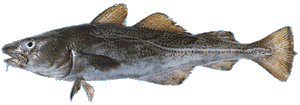
Image Source:Regulatory Fish Encyclopedia, Office of Seafood and Office of Regulatory Affairs, Food and Drug Administration
COSEWIC (Committee on the Status on Endangered Wildlife in Canada) has classified the Newfoundland & Labrador population of the Atlantic Cod as "Endangered" - a species facing imminent extirpation or extinction and some other populations as "Threatened" - a species likely to become endangered if limiting factors are not reversed. . Some local populations of cod are extinct near Maine and possibly near Nova Scotia.
In 1998, Dr. Kim Bell, who studied the status of the cod for COSEWIC, had recommended an "Endangered" classification. This conclusion was disputed by the Canadian Department of Fisheries and Oceans.
The Atlantic Cod population in question are typically found on or near the bottom of the continental shelf off the east coast of North America between New York and Labrador. They grow to about 6 feet in length and weigh an average of 6-12 pounds although there are reports of fish weighing well over 100 pounds.
The primary cause of the decline of the Atlantic Cod has been overfishing. Despite the closure of the east coast fisheries in Canada, the Cod population has not recovered. The Department of Fisheries and Oceans is pointing to:
COSEWIC is composed of representatives from:
The IUCN (International Union for the Conservation of Nature) - World Conservation Union - put the Atlantic Cod on its "red list" of species at risk of extinction in 1996. The Department of Fisheries and Oceans protested this rating.
Cod may have been an extreme example of technology getting ahead of the ability to manage it. It has been suggested that improvements in the technology for locating schools of cod enabled large catches to be maintained despite a continually declining fish population. It is also possible that the cod were congregating in large groups on their spawning grounds - a good survival tactic against natural predators but an unsuccessful strategy against "super-trawlers".
Even if these cod don't have the same appeal as other "cuter" animals, they have been a cornerstone of the economy of the North Atlantic for over 500 years. If we aren't capable of looking after such a "bread and butter" species, we should include ourselves on the list of species at risk.
![[home]](gsbann.gif)